Jumpstart your sketchbook with wild ideas—sketch old castles or funky retro objects, doodle your favorite snacks, or invent wacky patterns. Try blind contour drawing with your eyes off the paper, go crazy with color blobs, or create textures using toothbrushes or leaves (trust us, it’s awesome). Master studies or gesture drawings can boost your skills fast. Every page is a new playground, so try weird mark-making, blend different styles, and watch your creativity unfold with each fresh idea revealed next.
Key Takeaways
- Experiment with blind contour and continuous line drawing to loosen up and boost confidence in your sketches.
- Create value and color studies to deepen your understanding of light, shadow, and palette combinations.
- Explore one subject drawn four different ways to unlock creative variations and personal style.
- Try mark-making with unconventional tools like sponges or toothbrushes to discover unique textures and effects.
- Recreate classic artworks through master studies to learn new techniques and get inspired by history.
From History
Whenever someone cracks open a fresh sketchbook, turning to history for inspiration can ignite a whole world of creative adventures.
Imagine sketching mysterious historical buildings—old castles, quirky Victorian houses, or epic ruins. Drawing these places can bring out hidden stories and maybe even make your pencil feel like a magic wand!
Exploring art history by recreating classic paintings, while giving a shoutout to the original artist, helps artists see how styles and tricks changed over time.
Capturing portraits of legendary figures from the past? It’s like practicing your skills while chatting with history itself!
Even old phones or retro cereal boxes can be awesome subjects, letting artists time-travel through design trends.
Each sketch can connect people to the creative heartbeats of long-gone eras.
Your Favorites
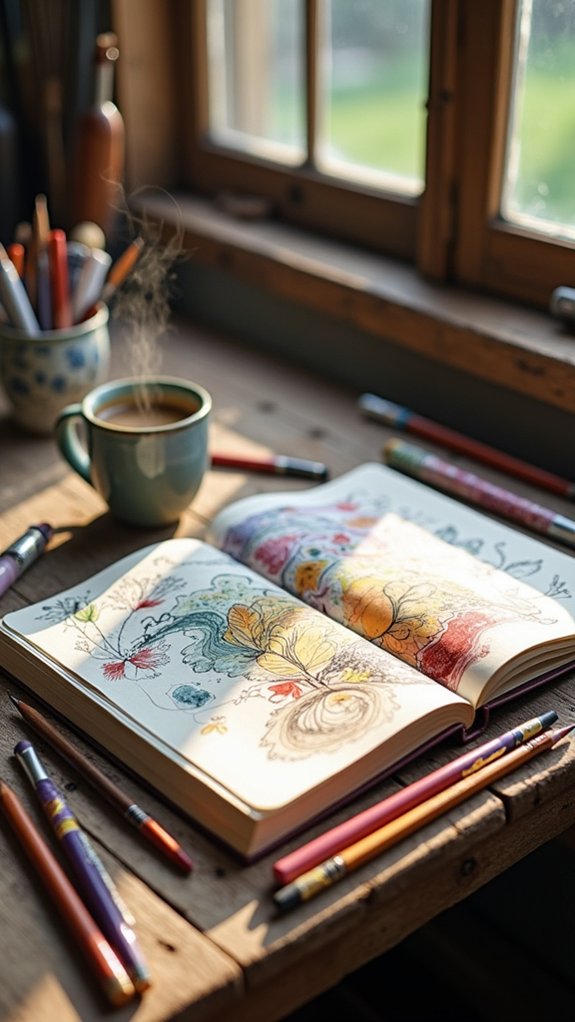
Favorites have a way of sneaking into every sketchbook, like secret ingredients in a recipe only you know. When looking for Sketchbook Ideas, drawing and painting things you love can make the creative process way more fun.
Ever tried illustrating a meal from your favorite restaurant? Go wild with those bright sauces or melty cheese—capture everything that makes it crave-worthy.
Or, sketch a favorite drink from that cool café, focusing on the fancy swirls of cream or the sparkly garnish.
Design your version of an article spread from your favorite magazine, using layouts and visuals that show off your personal style.
Even painting a print inspired by a beloved store or a cherished memory adds a slice of you to every page—now that’s creativity!
Around the House
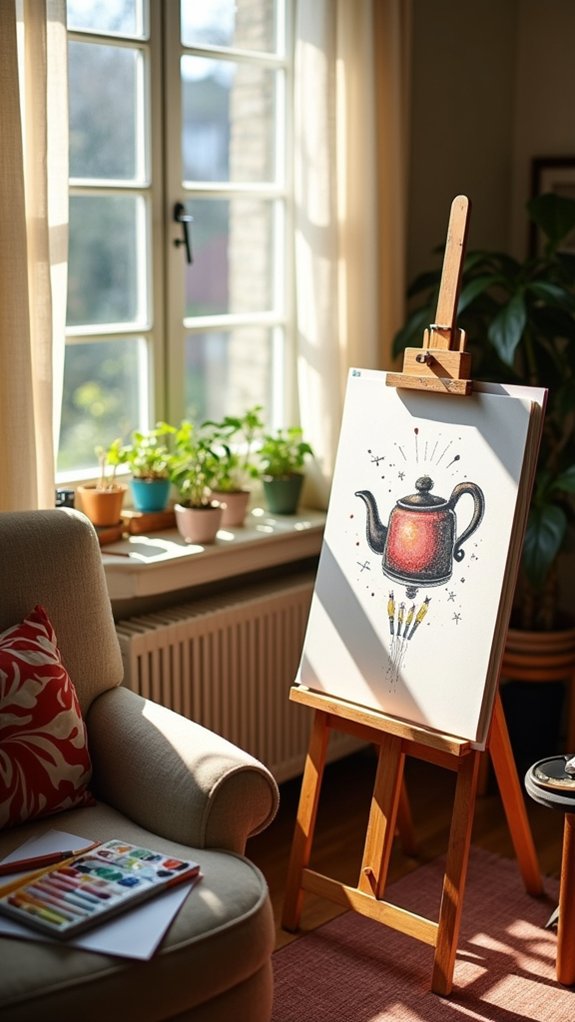
Around the house, every little thing has the potential to inspire seriously cool sketches, from a jumble of paperclips on a desk to that wild patterned sweater squished in your closet.
Ordinary objects, goofy pets, and even the funky weave of a blanket are secretly waiting for their moment to shine on the page—if you look at them closely enough, they turn into mini works of art!
With just a sketchbook and some curiosity, your home instantly becomes the world’s weirdest, most creative museum.
Everyday Objects as Art
A cereal spoon, a stack of well-read books, or a single battered sneaker—sometimes, the most unlikely things make the coolest art.
Everyday objects can be transformed into masterpieces with a bit of creative exploration and a sharp eye for their quirky shapes or wild textures. It’s not about having fancy supplies; it’s about seeing something new in what’s already around you.
Want some quick inspiration? Check out these sketchbook ideas:
- Collect a bunch of tiny random items and arrange them for an unpredictable still life.
- Zoom in on the wildest patterns in your favorite mug or that ancient sofa throw.
- Draw the same object in pencil, colored marker, or paint to see how different it can look.
- Pick something that matters to you—a lucky charm or heirloom—for extra emotional punch.
Styling Closets Creatively
After scoping out cool art opportunities in the stuff people use every day, it turns out closets have their own secret creative powers just waiting to be discovered.
Organizing a closet by color or style isn’t just good for finding socks—it can totally turn the space into a mini fashion gallery. Creative organization tricks, like stacking shoes on display shelves or tossing scarves in decorated boxes, make it easy and fun to play dress-up every morning.
Swapping clothes for different seasons keeps things fresh, and it’s like getting a new wardrobe without going shopping. Adding personal flair—maybe a funky mirror or an art print—makes the closet a joy to visit.
With a dash of creativity, even a boring closet can surprise you!
Capturing Home Textures
Some of the coolest art inspiration is literally hiding in plain sight—just look at all the different textures scattered around the house.
Drawing these textures isn’t just fun, it also challenges you to see everyday items in new ways. Go ahead—investigate how scratchy a woven rug looks or how a smooth ceramic vase shines.
Try using hatching, cross-hatching, and even a splash of watercolor to show off what you find. Want some ideas to get started?
- Study the pattern and texture of your kitchen towels or oven mitts.
- Sketch the grainy, knobby wood of tables and chairs using different pencil strokes.
- Draw shiny doorknobs or silverware, testing how light plays across metal textures.
- Mix pencil and colored washes to make your everyday objects stand out.
Use Your Imagination
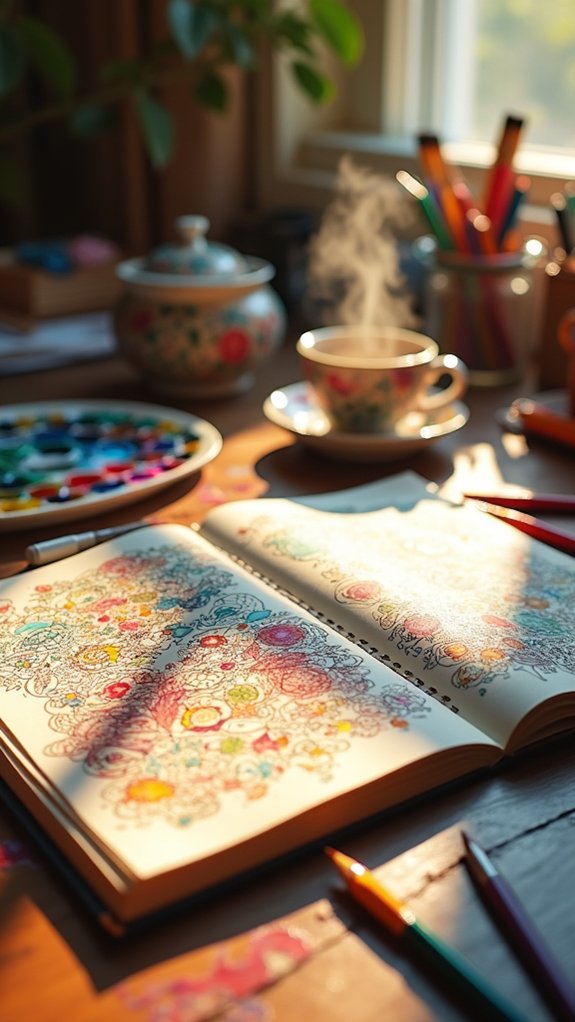
Even if it sounds a little wild at first, letting the imagination take the lead is where the real magic happens in a sketchbook.
Sometimes it means drawing a creature with the horns of a ram, the tail of a cat, and the wings of a parrot—just because you can.
Or, what if your toaster suddenly grew a face and arms, determined to make toast all by itself? That’s how your creative voice breaks free!
Blow up something ordinary, like a birthday cake the size of a car, or sneak a single silly object into a lineup of serious ones.
Drawing a forest with a floating island or gigantic daisies isn’t cheating—it’s just your imagination running wild, and that’s where the coolest ideas come from.
Pattern
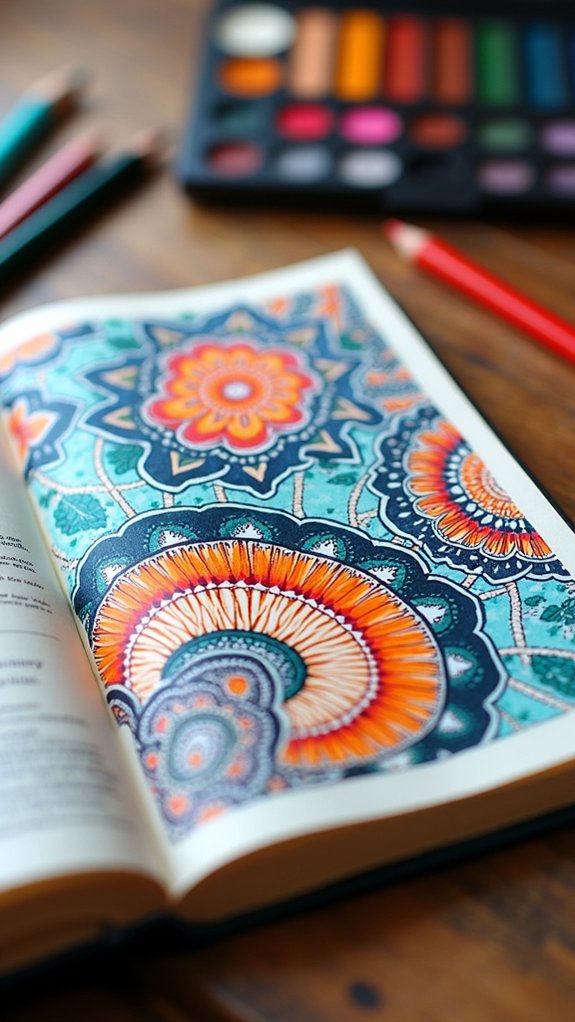
When it comes to sketchbook ideas, patterns are like secret codes for creativity—once someone starts investigating them, it’s hard not to get hooked!
Patterns give artists a way to express their unique creative voice while experimenting with repetition, color, and shapes. Imagine designing a pattern for a scarf—suddenly, you’re thinking about how it looks up close and from far away, if the fabric is soft or stiff, if the colors pop or blend.
Patterns can be simple or wild, but they always say something about the person who made them. Here are some cool ways to immerse yourself in patterns:
- Create a wallpaper pattern with a repeating theme
- Use only three favorite colors for abstract patterns
- Draw only with straight lines for geometric challenges
- Invent a personal motif that screams “you!”
No-Pressure Sketchbook
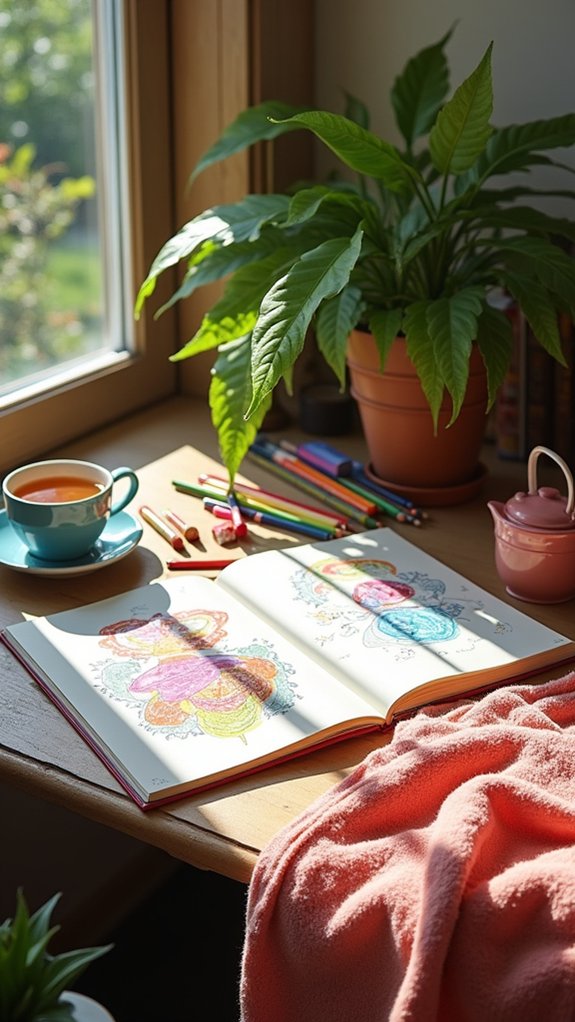
Crack open a no-pressure sketchbook and suddenly, art feels less like a dare and more like an adventure. There’s something magic about knowing you can fill the page with absolutely anything—giant doodles, weird color blobs, or even just wild scribbles.
Since nobody expects perfection, the pressure drops and creativity gets a real boost. Using a no-pressure sketchbook with thin, cheap paper? Go ahead, splash on watercolors or test funky markers. If the page wrinkles, smile—those crinkles are battle scars of creativity.
Filling page after page helps artists break through mental blocks and shake off the fear of messing up. It’s about having fun, making mistakes, and building artistic confidence, one imperfect masterpiece at a time. Imperfect is the new awesome!
Blind Contours & Continuous Line Drawing
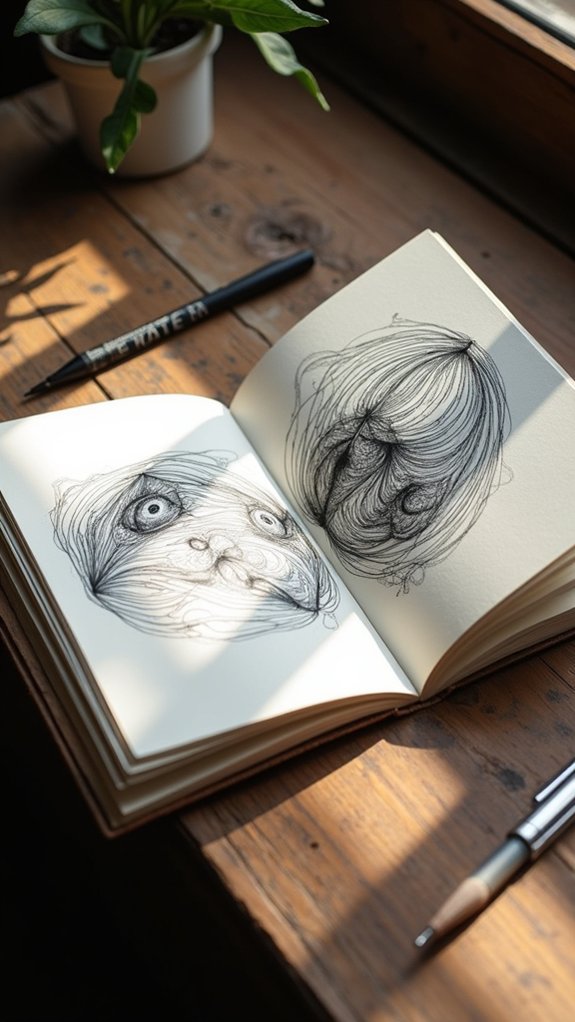
Blind contour and continuous line drawing are like fun brain workouts for artists—they boost hand-eye coordination and force you to trust your instincts, even when your lines look a little wild.
These sketchbook games are full of surprises, so mistakes are pretty much guaranteed, but that’s part of the adventure!
As artists practice, they start catching details they never noticed before, turning those quick, quirky sketches into a secret weapon for seeing and drawing better.
Enhancing Hand-Eye Coordination
Although balancing a pencil and staring at a subject like it’s about to tell a secret might sound a bit intense, sketchbook exercises such as blind contour and continuous line drawing can boost hand-eye coordination in ways most people don’t expect.
These techniques are all about enhancing hand-eye coordination while sharpening observation skills. Instead of worrying about a perfect drawing, artists can engage in these activities and just let their hands and eyes do the work together.
Here’s what makes these exercises so cool:
- Blind contours demand intense focus on the subject, training eyes and hands to work as a team.
- Continuous line drawing improves drawing flow and builds confidence in each stroke.
- Mistakes don’t matter—freedom rules.
- Warm-ups like these loosen up creativity and set the tone for awesome art sessions.
Embracing Unexpected Results
Sometimes, the best art happens when things don’t go exactly as planned. Blind contour drawing is like a wild art adventure—you draw without peeking at your paper. That’s right, eyes on your subject only! The result? Unexpected shapes that definitely look different from ordinary sketches, but that’s part of the fun.
Continuous line drawing adds its own twist: you draw a subject without lifting your pencil, letting your lines loop and swirl in surprising ways. Both techniques work as awesome drawing prompts that help you loosen up and embrace whatever appears on the page.
Artists might find quirky faces, weird hands, or creatures that never existed before. Messing up isn’t just okay—it’s actually where new creative ideas are born.
Developing Observational Skills
If goofy hands and wiggly faces from unexpected results sound fun, there’s a way to get even better at spotting cool details in the world: ramp up those observational skills using blind contours and continuous line drawing.
Blind contour drawing is like a game—no peeking at your paper! Instead, your pencil follows your eyes around the subject, which surprises you with weird shapes and funny lines. Continuous line drawing means your pencil never leaves the page, making everything connect in a twisty, flowing way.
Both of these artsy tricks are awesome for building hand-eye coordination and really noticing what you draw.
- Boosts how well artists see and understand shapes
- Makes drawing loose, bold, and expressive
- Teaches seeing the “big picture” versus tiny details
- Grows confidence through unique, quirky sketches
Draw With Your Non-Dominant Hand
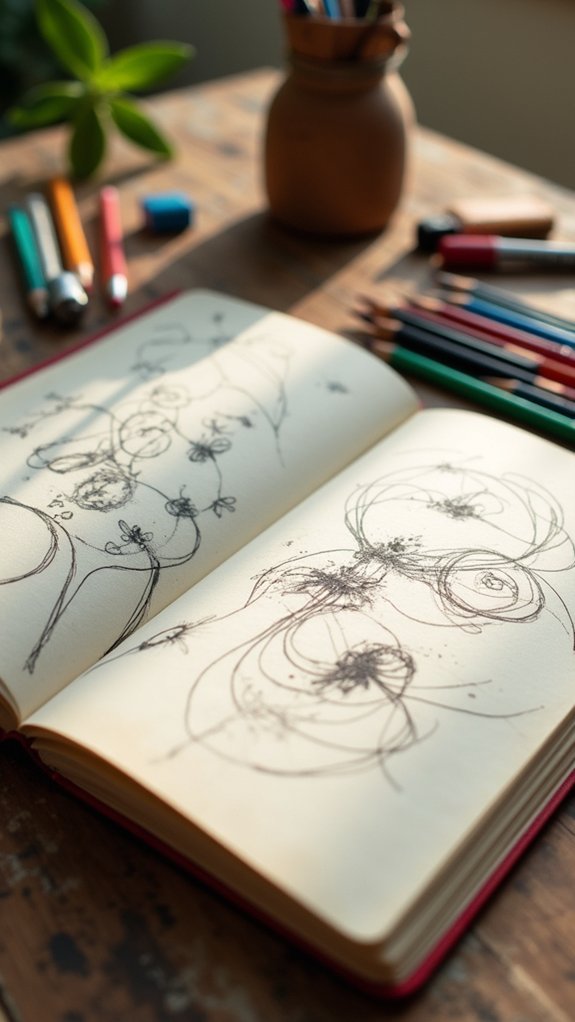
Even though it might sound a little wild at first, drawing with your non-dominant hand is one of those sketchbook challenges that can feel both hilarious and surprisingly rewarding. It’s a total game-changer for practice drawing—especially if you try sketching something tricky, like drawing buildings. Since your non-dominant hand isn’t used to art, you get unpredictable, wobbly lines that give your work a quirky charm. This practice helps shut down your inner perfectionist, making it easier to enjoy the process and laugh at the results. Plus, focusing on shapes instead of muscle memory amps up your observation skills. Over time, using your non-dominant hand builds dexterity and hand-eye coordination, and honestly, it’s just plain fun.
| Benefit | How It Helps | Fun Factor |
|---|---|---|
| Unique Sketches | New styles emerge | 8/10 – Quirky! |
| Reduced Self-Judgment | More freedom | 9/10 – Hilarious |
| Improved Observation Skills | Focused drawing | 7/10 – Surprising |
| Increased Dexterity | More control | 8/10 – Rewarding |
Composition Studies & One Subject Four Ways
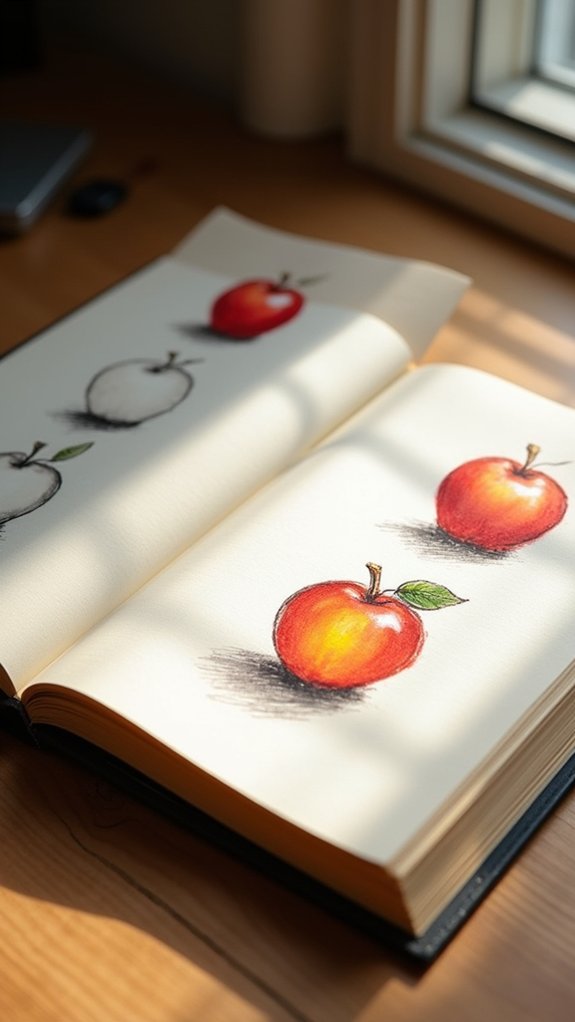
While sketching the same old things can get boring fast, composition studies and drawing one subject four ways are like a creativity power-up for any sketchbook.
Instead of just doodling random stuff, try picking one subject—a shoe, a leaf, or even your favorite snack—and explore that object in four totally different styles or moods.
Composition studies help you see cool layouts by boxing in your drawings, making you think about placement and focus. Drawing your subject in various ways helps you discover your unique artistic voice and pushes you to experiment.
Want a mini creative challenge? Try these:
- Draw your subject from four different angles
- Switch up styles (realistic, cartoon, abstract, scribbly)
- Test out new tools or colors
- Play with wild backgrounds or unexpected settings
Value Studies & Simple Shapes and Shading

Now comes the fun part—figuring out how to make your drawings pop just by playing with light and dark!
Value studies let artists experiment with shadows and highlights, while simple shapes and easy shading tricks help sketches look solid and three-dimensional, like they could almost jump off the page.
Who knew a plain old cube or sphere could turn into a secret weapon for awesome, eye-catching art?
Exploring Light and Dark
The magic of shadows and highlights can totally change the way a drawing feels. Artists looking to boost their sketchbook skills might plunge into value studies. These are all about the difference between lights and darks, and figuring out what gives a drawing its punch.
When things feel complicated, breaking complex subjects into basic shapes—like cubes or spheres—makes it easier and way less scary to start sketching. The fun part? Experimenting with different tools or methods to bring those dramatic contrasts to life!
- Try using markers or watercolor washes to test how light and dark play together.
- Turn wild, complex scenes into simple shape versions first.
- Focus on just the values, not the colors—black, white, and grays are your pals.
- Shade quick sketches daily to flex your value muscles!
Building Volume With Shading
Magic happens when flat shapes suddenly pop into 3D just by adding some shading. It’s like watching your drawing go from a pancake to a basketball!
Value studies are a great way to practice this, since they teach artists to spot light and dark areas, making everything look more solid and real. Skipping color for a bit and drawing only with charcoal or graphite—just shades of gray—lets you focus on what really matters: those awesome shadows and highlights.
Try breaking a subject down into simple shapes before shading, like cubes or spheres. Then, explore different shading techniques, like hatching and cross-hatching, to show how light wraps around each object.
Before you know it, your sketches will be bursting with volume and life!
Add Some Color & Color Studies
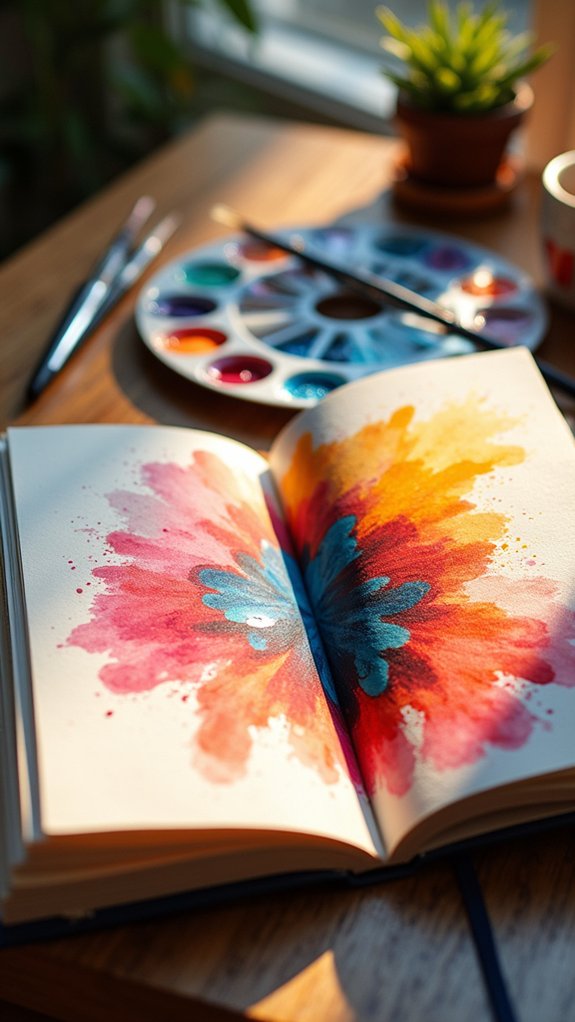
Even if a pencil sketch looks awesome, adding a splash of color can totally transform it—from cool to jaw-dropping. That’s the magic of color studies!
Trying out different palettes gives artists creative freedom, letting them play without worrying about making mistakes. Watercolor washes are awesome for seeing how different colors mix and add depth.
Some folks make a special section in their sketchbook just for color experiments, which is great for future inspiration—or just to admire all those bold combos.
Want a few ideas to keep things interesting?
- Explore warm vs. cool palette battles, and pick your favorite “team.”
- Layer watercolor washes to see colors interact in surprising ways.
- Pair totally unexpected colors together for dramatic contrast.
- Document favorite palettes and finished color studies for future masterpieces.
Mark Making & Experiment With Textures
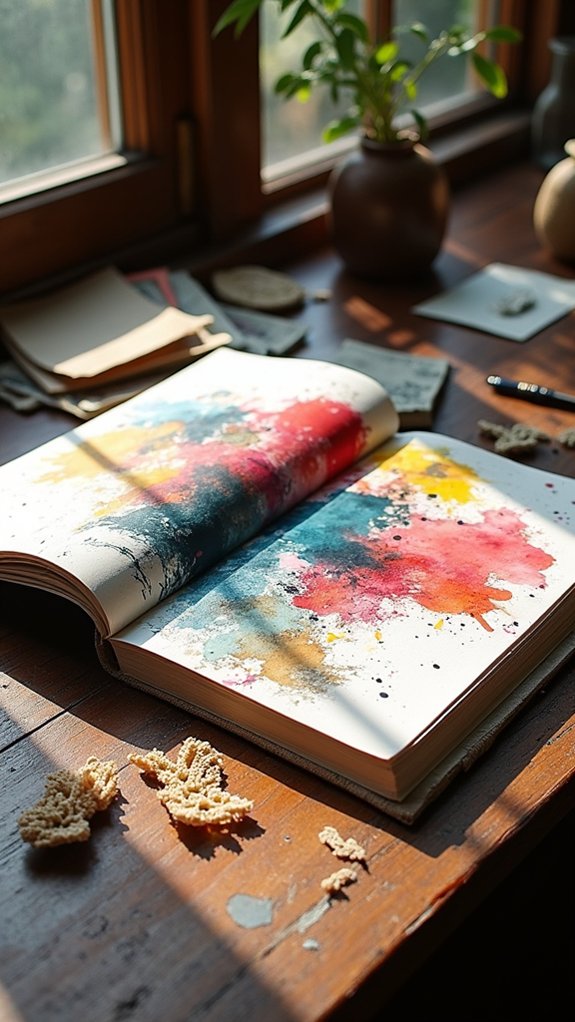
Ready to make your sketchbook jump off the page? Playing around with different mark-making tools—like sponges, brushes, or even a fork from lunch—can create all kinds of wild surface effects, so no two pages ever look the same.
Try stacking marks on top of each other in different directions or patterns, and watch how cool layered textures can add instant depth, almost like your art has secret passages hiding in it!
Exploring Different Mark Tools
Although some might think drawing is just about making lines on a page, exploring different mark-making tools can completely transform artwork, sometimes in wild and unexpected ways.
Experimenting with a variety of materials doesn’t just spice up a sketchbook—it bursts open a whole new world of creative possibilities. It’s not about being a “fancy artist” but more about having fun and taking risks with what you use to make marks.
From smudgy charcoal fingers to scratchy twigs dipped in ink, the options are nearly endless, and hey, nobody’s grading you.
- Try using pencils, pens, brushes, or even sticks and sponges to make new marks.
- Play with techniques like stippling, cross-hatching, or wild scribbling.
- Mix it up with charcoal, pastel, or vibrant colored inks.
- Keep a fun reference sheet of your favorite marks for future experiments.
Creating Unique Surface Effects
Jump right into texture territory, and watch sketches come alive in ways that plain lines just can’t pull off.
With mark making, artists use not just brushes or pens, but anything from old toothbrushes to leaves found outside to create wacky, wonderful textures. Think cross-hatching for roughness, stippling for pebbly surfaces, or pressing a crumpled paper towel dipped in watercolor for weird, bumpy patterns.
The options are endless, and honestly, there’s no “wrong” way to experiment. Trying out different tools and mediums—like charcoal or ink—can spark totally new ideas.
Keep a little texture reference book to jot down those cool effects; it’s like a secret menu for your art. Every swipe, dot, or scratch adds attitude and intrigue, making sketches unforgettable.
Layering Techniques for Depth
Stacking marks and textures is where the real magic of sketching starts to happen, turning flat doodles into mini worlds packed with depth.
Layering techniques aren’t just fancy art terms—they’re secret hacks that help make your sketches pop. Imagine turning a boring blob into a wild jungle with a few well-placed lines, swirls, or dabs.
By experimenting with different tools and methods, anyone can add super cool textures and depth to their work. Here’s how:
- Try cross-hatching or stippling for shadows and highlights—they’re like cheat codes for depth.
- Grab sponges or even your fingers to make surprising new marks.
- Layer ink on top of watercolor for rich, mysterious effects.
- Press leaves or fabric into your sketchbook to create one-of-a-kind patterns.
Let your textures do the talking!
Master Study
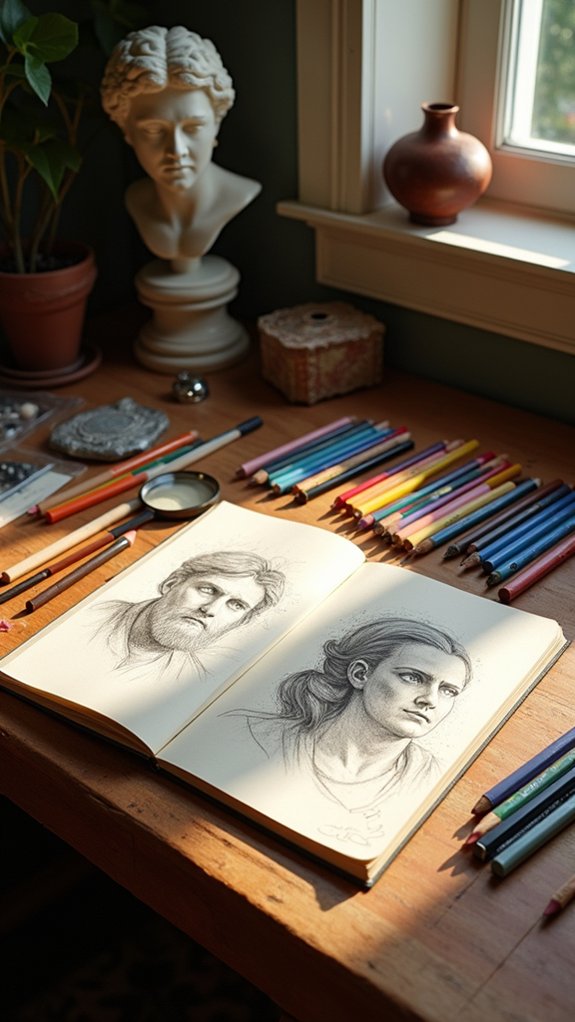
Many young artists get a creative boost by diving into a master study, where they pick a famous painting or drawing and try to copy it—kind of like borrowing someone else’s “art superpowers” for a bit.
Master studies aren’t just about tracing lines; they’re a secret handshake with legendary artists. Whether someone chooses a quick, loose sketch or a crazy detailed replica, the real gold is found when they zoom in on things like brushwork, color palettes, and those weird little textures.
As they copy, artists start to wonder, “Why did the master pick that color?” or “How did they get that effect?” They might even surprise themselves, discovering which styles make their heart race, helping shape their own artistic voice for future projects.
Gesture Drawing
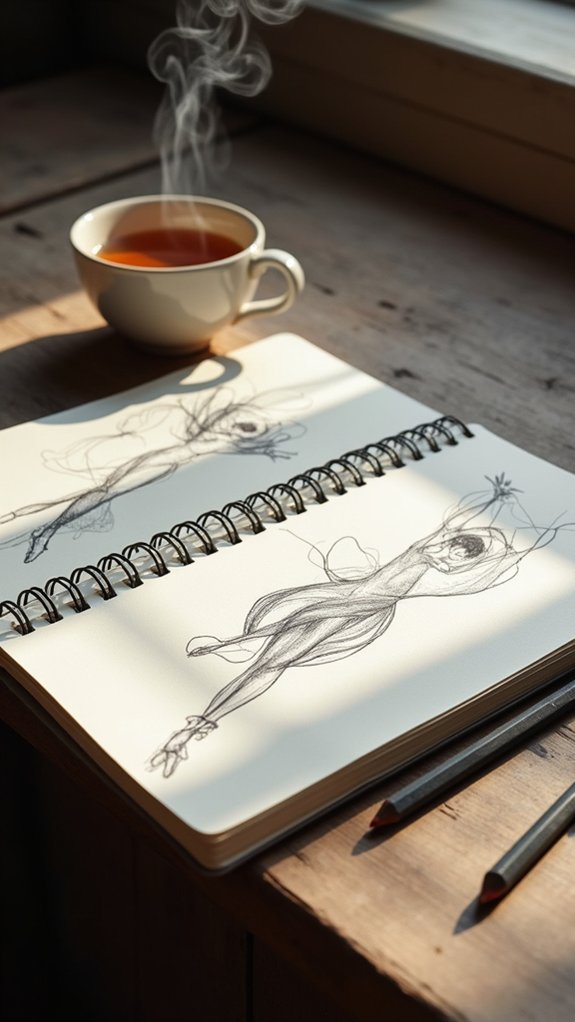
Even before an artist worries about tiny details or perfect shading, gesture drawing steps in like a friendly warm-up coach, urging them to feel the motion first.
With gesture drawing, artists capture the energy of a person or object in just 30 seconds to 2 minutes—quick, but packed with meaning! It’s less about nailing every detail and more about sketching the action and attitude.
Since creative business since forever, gesture drawing has helped artists level up their observation game, making their art feel dynamic and alive. Regular practice can really loosen up your hand (and your brain), setting the stage for more confident, detailed work later.
Here are some cool things gesture drawing can do:
- Build confidence
- Enhance observation
- Improve anatomy skills
- Boost spontaneity
Frequently Asked Questions
What Should I Draw First in My Sketchbook?
When considering what to draw first in a sketchbook, one might begin with character studies to explore expressive features, or nature sketches to practice observing organic forms, providing both technical growth and creative engagement from the start.
How Do You Spark Creativity When Drawing?
To spark creativity when drawing, one might utilize art prompts or engage in visual journaling. These methods help bypass creative blocks, encourage exploration of new themes, and inspire fresh artistic directions by providing structure and meaningful reflection.
What to Draw 100 Ideas?
When considering what to draw, a creator might explore nature scenes, abstract patterns, character sketches, everyday objects, fantasy creatures, dream vistas, famous landmarks, seasonal themes, food illustrations, animal portraits, emotional portraits, mythical beings, historical figures, and more.
How Should I Start My Sketchbook?
To begin a sketchbook, one should explore sketching techniques through warm-up exercises and experiment with various mediums. Incorporating creative prompts can inspire initial pages, while focusing on simple subjects helps develop skills and encourages free, expressive drawing.
Conclusion
So, with these 14 sketchbook ideas, anyone’s creativity can go from zero to sixty. Seriously, no one wants to stare at a blank page forever—unless that’s your thing (no judgment). Whether you’re sketching your favorite snack or inventing wild patterns, each page is a new adventure. Don’t be shy to make mistakes, either. That’s part of the fun. Grab your sketchbook and let your imagination take the wheel. Who knows where your pencil will lead you next?

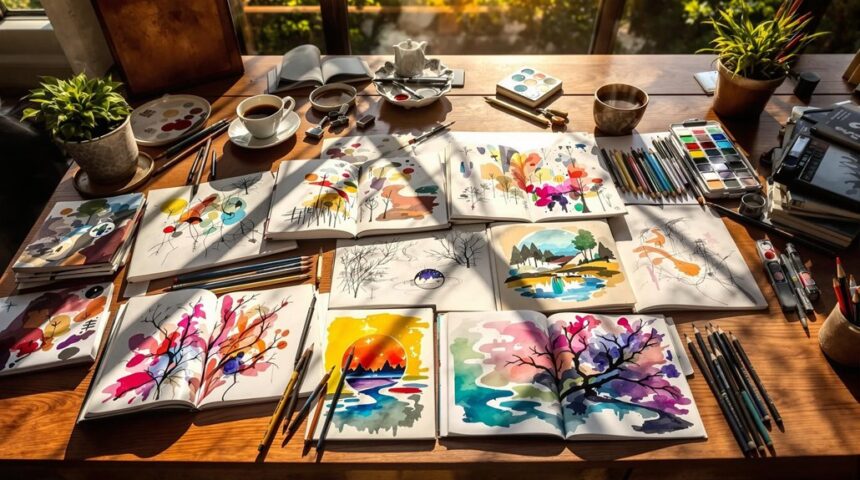
Leave a Reply